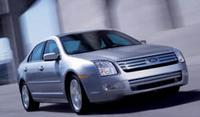Ford Residual Values Ticks Upwards
Vincentric’s Best Value in America™ Awards
By Mike Thomas, FCN
Dearborn MI January 19, 2006; Ford Motor Company's efforts to increase the residual (resale) values of its vehicles are paying off for both the company and consumers.
Taken as a whole, Ford and Lincoln/Mercury brands have increased in residual values from 40 percent after the third year-in-service for 2004 models in calendar year 2004 to 41.8 percent for 2006 models in Automotive Lease Guide's (ALG) most recent residual forecasts. That compares to around 30 percent for such cars as the Taurus.
For many individual models, the residuals are even better. For example, the new Fusion SE is rated at 47 percent after a three-year period. Translated into dollars, that means the SE should command a resale price of 47 percent of its original MSRP (Manufacturer's Suggested Retail Price). And in a bit of surprise to the company, approximately one in four Fusions are being leased because of strong residuals, helping Ford's market share through increased leasing business.
"The key to improving residual values is to realize that residual values are fundamentally impacted by decisions made throughout the product lifecycle, even though it is measured at remarketing time," said Rose Peng, manager, Revenue Modeling & Global Lifecycle Analytics (GLAD). "We see increased residual values when we incorporate residual improvement strategies early into the decision making process."
Ford has undertaken a major project to incorporate all of the variables involved in generating revenue for the company in an integrated manner. Residual values are one piece of the puzzle as is product design and new-car pricing, but more importantly is the ability to make the different pieces all fit together.
"In Revenue Modeling and GLAD, we are developing a very sophisticated set of tools that allow us to analyze the whole lifecycle of the products," Peng said. "We collect as much data as possible, calibrate the data, and then feed all the significant variables impacting residual values into our models to get a complete picture of and insights about resale values."
Peng singled out several of the most important factors influencing residual values. "First is the product itself which must offer a fresh, bold, and exciting style to consumers, things that surprise and delight consumers, as well as durability and reliability," Peng said.
"Second, the vehicle must be priced right in terms of its MSRP to reflect the net transaction price consumers pay to close a transaction. And the company needs to set the right production volumes and adjust the balance between retail and fleet/rental sales to meet the natural market demand."
Taking the Fusion as an example, initial reactions suggest that Ford's engineers and designers have come up with an exciting product. GLAD hosted an exposure event for the Fusion, Milan and Zephyr last year for such major players in setting residuals as Automotive Lease Guide, Edmunds and Kelley Blue Book, among others. Reactions were decidedly positive.
"Surprised and delighted," said Bob Kurilko of Edmunds. "Product right and price right."
"The feel of a sports car with the refinement of a sedan," said Brian Drake of J.D. Power. "An aggressive, bold vehicle."
Ronnie Ransom of Black Book picked up on an important, yet very subtle, aspect of residual value determination -- option packages. "Wonderful job in grouping options," Ransom said. "The most simple car to order that I have seen in quite some time."
As exciting as a vehicle may be, it can still fail in the marketplace if the pricing is unrealistic. "It's crucial to establish the right MSRP and that means setting a price that is as close as possible to the actual transaction prices commanded by a vehicle," Peng said.
An artificially high MSRP cannot sustain itself in the marketplace, forcing manufacturers into one of two options, neither of which is pleasant. Automakers can either offer discounts, which creates the impression that the vehicle isn't worth all that much to begin with, or the automaker can clear their inventories by selling more vehicles to rental companies which will flood the used car market with nearly new used vehicles and negatively impact resale prices.
When pricing its new vehicles, Ford set realistic MSRP values, leading to such price structures as the Fusion starting around $17,400. Several participants at last year's exposure event approved of Ford's pricing. And so far, Ford has seen increased Fusion sales without resorting to incentives.
While improved residuals on Ford's brand new models are important, some of Ford's previous models have also shown improvement. The Explorer, Five Hundred and Freestyle have all shown strong residual value.
Taken as whole, Ford's strategy is to develop vehicles as a complete package, from product creation at the beginning to residual values at the end. If the company succeeds, then as Rose Peng said, "We will create a market in which customers 'pull' our vehicles to them instead of our having to 'push' the supply out."



